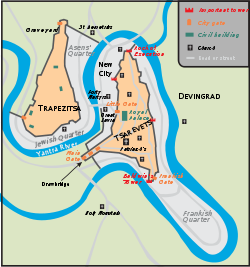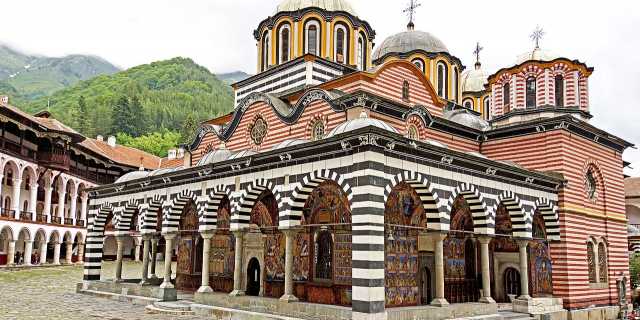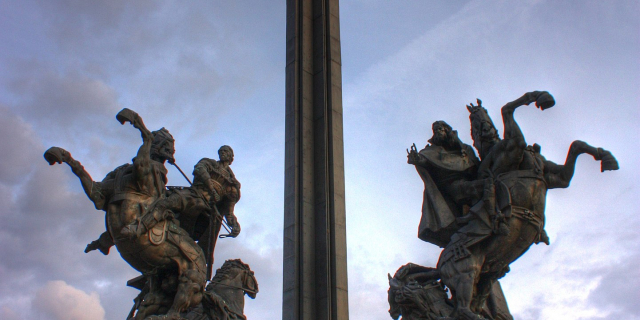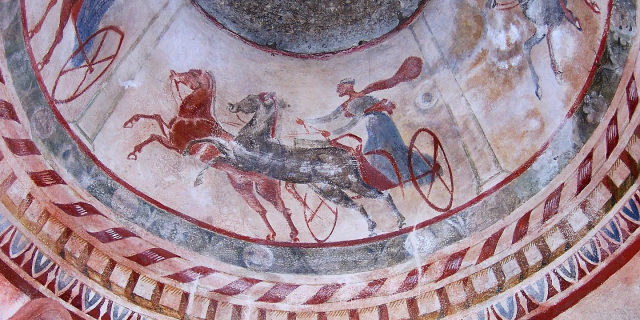Veliko Tarnovo (Bulgarian: Велико Търново, romanized: Veliko Tyrnovo, pronounced [vɛˈliko ˈtɤrnovo]; "Great Tarnovo") is a city in north central Bulgaria and the administrative centre of Veliko Tarnovo Province. It is the historical and cultural capital of Bulgaria.
Often referred to as the "City of the Tsars", Veliko Tarnovo is located on the Yantra River and is famously known as the historical capital of the Second Bulgarian Empire, attracting many tourists with its unique architecture. The old part of the town is situated on three hills, Tsarevets, Trapezitsa, and Sveta Gora, rising amidst the meanders of the Yantra. On Tsarevets are the palaces of the Bulgarian emperors and t...Read more
Veliko Tarnovo (Bulgarian: Велико Търново, romanized: Veliko Tyrnovo, pronounced [vɛˈliko ˈtɤrnovo]; "Great Tarnovo") is a city in north central Bulgaria and the administrative centre of Veliko Tarnovo Province. It is the historical and cultural capital of Bulgaria.
Often referred to as the "City of the Tsars", Veliko Tarnovo is located on the Yantra River and is famously known as the historical capital of the Second Bulgarian Empire, attracting many tourists with its unique architecture. The old part of the town is situated on three hills, Tsarevets, Trapezitsa, and Sveta Gora, rising amidst the meanders of the Yantra. On Tsarevets are the palaces of the Bulgarian emperors and the Patriarchate, the Patriarchal Cathedral, and also a number of administrative and residential edifices surrounded by thick walls.
Trapezitsa is known for its many churches and as the former main residence of the nobility. During the Middle Ages, the town was among the main European centres of culture and gave its name to the architecture of the Tarnovo Artistic School, painting of the Tarnovo Artistic School, and to literature. Veliko Tarnovo is an important administrative, economic, educational, and cultural centre of Northern Bulgaria.
 Tsarevets palace
Tsarevets palace Map of medieval Tarnovo
Map of medieval Tarnovo Patriarchal Cathedral
Patriarchal CathedralVeliko Tarnovo is one of the oldest settlements in Bulgaria, with a history of more than five millennia. The first traces of human presence, dating from the 3rd millennium BC, were discovered on Trapezitsa Hill.[1]
First Bulgarian stateTarnovo was a stronghold of the First Bulgarian Empire. A number of coins, specimens and ceramics from the First Bulgarian State were found on the hills on which the capital city of Tarnovgrad stretched.[1] The city was important for the first Bulgarian state. There was an important military garrison in it. In the church of St. Forty Martyrs specimens were found that historians believe are the work of Bulgarians from Volga Bulgaria.[citation needed]
Uprising of Asen and PeterThe Uprising of Asen and Peter began on 26 October 1185, the feast day of St. Demetrius of Thessaloniki, and ended with the restoration of Bulgaria with the creation of the Second Bulgarian Empire, ruled by the Asen dynasty. Old Tarnovo would serve as the capital.
Medieval Bulgarian rule Veliko Tarnovo in 1885
Veliko Tarnovo in 1885Veliko Tarnovo, originally Tarnovgrad (Търновград), grew quickly to become the strongest Bulgarian fortification and most prosperous city during the second half of the High and the Late Middle Ages and also most important political, economic, cultural and religious centre of the empire. In the 14th century, the city was described by Bulgarian cleric Gregory Tsamblak as "a very large city, handsome and surrounded by walls, with 12,000 to 15,000 inhabitants".,[2] the fortress of Tsarevets being the primary fortress and strongest bulwark from 1185 to 1393, housing the royal and the patriarchal palaces.
In the 14th century, as the Byzantine Empire weakened, Tarnovo claimed to be the Third Rome, based on its preeminent cultural influence in Southeastern Europe.
As the capital of the Second Bulgarian Empire, Tarnovo was a quasi-cosmopolitan city, with many foreign merchants and envoys. Tarnovo is known to have had Armenian, Jewish and Roman Catholic ("Frankish") merchant quarters, besides a dominant Bulgarian population. The discovery of three Gothic heads of statuettes indicates there may have also been a Catholic church.[3]
Ottoman rule Tarnovo, painting by Felix Kanitz
Tarnovo, painting by Felix Kanitz The Prolom Dervent
The Prolom Dervent Yantra river
Yantra river Old Tarnovo part
Old Tarnovo partThe political upsurge and spiritual development of Tarnovo were halted when the Ottoman Empire captured the city on 17 July 1393.[citation needed] The siege lasted for three months, with the Bulgarian Patriarch Evtimiy leading the defence.[4] Three years later, the Ottomans conquered the entire Bulgarian Empire.
Bulgarian resistance against Ottoman rule remained centred in Tarnovo (then known as Tırnova) until the end of the 17th century. Two major anti-Ottoman uprisings – in 1598 and in 1686 – started in the city. Tarnovo was consecutively a district (sanjak) capital in the Rumelia Eyalet, in the Silistria Eyalet, and finally in the Danube Vilayet.
 Grand Prince Nikolay Nikolaevich Enters Tarnovo - painted by Nikolai Dmitriev-Orenburgsky in 1883, depicting the city's liberation. In it General Gurko rides behind the Grand Prince at his left side
Grand Prince Nikolay Nikolaevich Enters Tarnovo - painted by Nikolai Dmitriev-Orenburgsky in 1883, depicting the city's liberation. In it General Gurko rides behind the Grand Prince at his left side Constituent Assembly of Bulgaria in 1879
Constituent Assembly of Bulgaria in 1879Tarnovgrad, along with the rest of present-day Bulgaria, remained under Ottoman rule until the 19th century, when national identity and culture reasserted themselves as a strengthening resistance movement. The goal of the establishment of an independent Bulgarian church and nation motivated the 1875 and 1876 uprisings in the city. On 23 April 1876, the April uprising marked the beginning of the end of the Ottoman occupation. It was soon followed by the Russo-Turkish War (1877–1878).
 Independence of Bulgarian 1908Third Bulgarian State
Independence of Bulgarian 1908Third Bulgarian State
On 7 July 1877, Russian general Joseph Vladimirovich Gourko liberated Veliko Tarnovo, ending the 480-year rule of the Ottoman Empire. In 1878, the Treaty of Berlin created a Principality of Bulgaria between the Danube and the Stara Planina range, with its seat at the old Bulgarian capital of Veliko Tarnovo. Due to the capture of Tarnovo by Russian forces, the Muslim refugees fled to Anatolia.
On 17 April 1879, the first National Assembly convened in Veliko Tarnovo to ratify the state's first constitution, known as the Tarnovo Constitution, resulting in the transfer of parliament from Tarnovgrad to Sofia, which today remains the Bulgarian capital.
In deference to the city's past, Tsar Ferdinand, of the House of Saxe-Coburg and Gotha, chose the Forty Holy Martyrs Church in Veliko Tarnovo as the place to declare the complete independence of Bulgaria on 5 October 1908.
In 1965, the city, then officially known as Tarnovo, was renamed Veliko Tarnovo (Great Tarnovo) to commemorate its rich history and importance.
People's Republic of BulgariaDuring Communist rule, the city underwent considerable changes, with some 10,000 of its population thought to have become members of the Bulgarian Communist Party (BCP) by the end of the 1940s. A number of its churches and private enterprises were closed, while the major industries were nationalized. In the early 1950s, the city underwent an intensive process of urbanization, expanding to the west. From the same period also dates the idea of creating a large urban area in Northern Bulgaria encompassing the neighboring city of Veliko Tarnovo and the towns of Gorna Oryahovitsa and Lyaskovets (popularly known as "Targolyas").
In 1963, the University of Veliko Tarnovo "St. Cyril and St. Methodius" opened as one of the largest institutions of higher education in the country. Urbanization continued during the 1970s, as the engineering, electronic, medical, computer, and furniture industries expanded in the region, adding the neighborhoods of Akacia and Kartala to the city's landscape.





























Add new comment